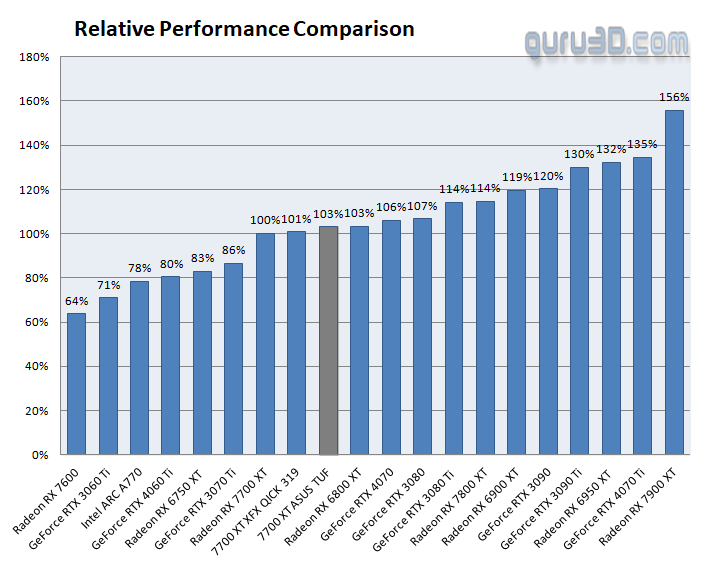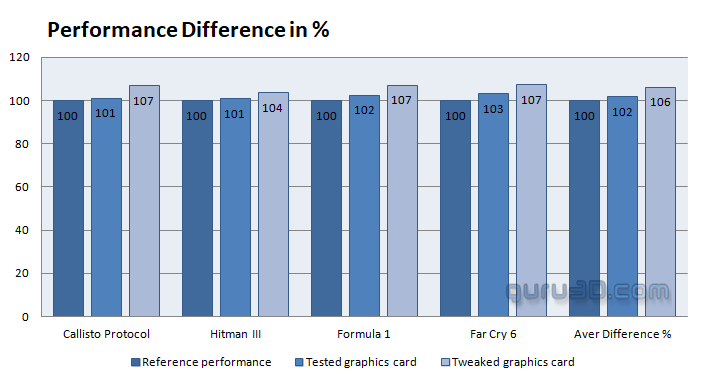Final words and conclusion
Final words
The TUF edition graphics card exhibits a 2-3% performance improvement compared to the reference edition and offers a broader range of BIOS options. The TUF edition is a well-constructed piece of hardware. It provides commendable WQHD performance and is loaded with advanced features. Notably, users can expect quiet operation and state-of-the-art temperature regulation. Pricing remains an essential factor in purchasing decisions. The TUF edition, showcasing a slight performance advantage over its reference version, aligns with ASUS's tradition of producing high-quality, low-noise GPUs. While design appreciation is subjective, its striking appearance does add to its appeal. Additionally, with minor adjustments, users can realize performance gains up to 7% over the standard Founder's Edition. This combination of flexibility and capability renders the TUF edition graphics card an excellent option for those pursuing an enhanced GPU experience. The RX 7700 XT series may not bring groundbreaking technical advances but does demonstrate incremental performance gains. In terms of performance, the RX 7700 XT is on par with its 6800 counterparts in this competitive market. While other products have their distinct advantages, potential buyers should thoroughly assess their options. The RX 7700 XT model provides 12GB of graphics memory and a 192-bit memory interface, positioning it as a favorable option for those weighing performance against cost.
Performance
The RX 7700 XT graphics cards offer proper rendering quality and capability suitable for mainstream to high-end gaming. Although it doesn't exhibit huge progression from its predecessors (6800), it demonstrates enhanced raytracing performance. Designed primarily for gamers who prioritize a new monitor, the RX 7700 XT and 7800 XT also support QHD monitor resolutions. Within the RX 7000 series, the upgraded rasterizer engine overcomes former performance constraints, highlighting notable raw shader engine capabilities. While NVIDIA's Raytracing and DLSS3 technologies surpass AMD's FSR2 and upcoming FSR3, the RX 7700/7800 XT's performance with FSR2 is still noteworthy, and enabling FSR is recommended. However, based on frametime results, AMD appears to have potential improvements to make at the driver level, as some stuttering was observed. Overall the XFX card was 1 maybe 2% faster than the reference.
Cooling & noise levels
Our test shows that gaming will get you an approximate volume level of an excellent 32-33 decibels, that is silent. Moreover, the graphics card temperature is around 55 degrees Celsius. Furthermore, our utilization of FLIR imaging failed to unveil any worrisome observations. We see no reason to use different BIOS modes.
Energy
Please keep in mind that the Radeon RX 7700 XT is positioned as a gaming product intended for the mainstream market and it consumes a fair amount of energy. When operating at maximum load, the reference edition draws approximately 235 Watts on average (total board power or TBP). This power consumption is directly linked to the amount of heat emitted by the GPU, which is situated within an enclosed casing.
Coil whine
Every graphics card will inevitably produce a discernible buzzing sound known as coil whine when operating at high FPS. Is it bothersome? It becomes noticeable once you push the frame rates to extremely high levels. In a closed computer case, this noise tends to recede into the background. However, when the chassis is open, the coil whine or squeal becomes audible. Almost all graphics cards exhibit this phenomenon to some extent, particularly when operating at higher frame rates. Despite its presence, we have not noticed it enough to be a significant inconvenience.
Pricing
The reference edition comes with a price tag of USD 449, which still can be considered substantial for a device primarily used for playing PC games in Full HD resolution. In the European Union, you must convert the currency and factor in the value-added tax, bringing the total to around 299-309 euros. Moreover, advanced AIB cards will be even more expensive. Based on MSRP this card, however, does offer the best bang for buck. This AIB card will, however cost roughly 475-500 USD.
Tweaking
The card can be effectively tweaked with ease; one beneficial feature is the power limiter, allowing for a wattage increase of up to +15%. This serves as the initial and fastest option for tweaking. By utilizing this option, you can achieve enhanced performance while staying within the card's default power allocation. Additionally, the boost clock frequency can be set at a suitable 2850 MHz, although it may dynamically fluctuate to approximately 2800 MHz due to variations in frequencies across different game titles. Furthermore, the memory can be optimized to operate at around 19.2 Gbps. When all these adjustments are combined, they result in approximately 5% additional performance gains in demanding GPU scenarios, measured relative to the baseline performance. Add to that the factory tweak offering 2%, and you're at 6-7% additional performance.
Conclusion
ASUS has introduced a high-quality graphics card designed for optimal performance in the WQHD arena, ensuring a balanced gaming experience. The TUF Gaming OC delivers a quiet BIOS noise level at 32-33 DBa and surpasses anything in it's path cooling-wise. Performance-wise, things are a bit dimmer, but expect 2-3% extra speed. The TUF card is tentatively priced around $469-479 (we haven't heard the final numbers yet, though), so that is subject to change. The Radeon RX 7700 XT series emphasizes rasterized shading, ensuring consistent QHD gaming. An added L3 cache significantly boosts performance, especially in Full HD / Quad HD resolutions and CPU-intensive games. Despite its impressive performance, sleek design, and reduced noise, the card has relatively high power consumption. While NVIDIA advances in Raytracing, Tensor, and AI-aided tasks, AMD has progress to make in these areas. Nonetheless, for rasterized shading gaming, the Radeon RX 7700 XT stands strong. This card appeals to those prioritizing both efficiency and aesthetics. However, potential obstacles include the anticipated pricing and availability. Despite these icky points, the card's standout attributes make it a feasible choice for gaming enthusiasts.
- Download AMD Radeon drivers
- Sign up to receive a notification when we publish a new article.
- Or go back to Guru3D's front page
- Hilbert, LOAD"*",8,1.
Note: Given the sentiment about award badges, we decided not to apply them to reference graphics card reviews.



